Hibiscus is a famous flowering plant of the tropics. It enjoys moist soil and warm temperatures. For growing them in your garden, you must understand their requirements. Today, we will discuss the watering needs of Hibiscus plants.
Hibiscus enjoys moist soil, so they need daily watering during the hot summer months. There is no such frequency in the winters, so you can water your Hibiscus only when the top 1-2 inches are dry to touch. Never keep the soil soggy and drowned at all times, resulting in overwatering.
There are many things to consider while watering Hibiscus plants which we will explore in this article. We will discuss all information regarding watering a Hibiscus plant.
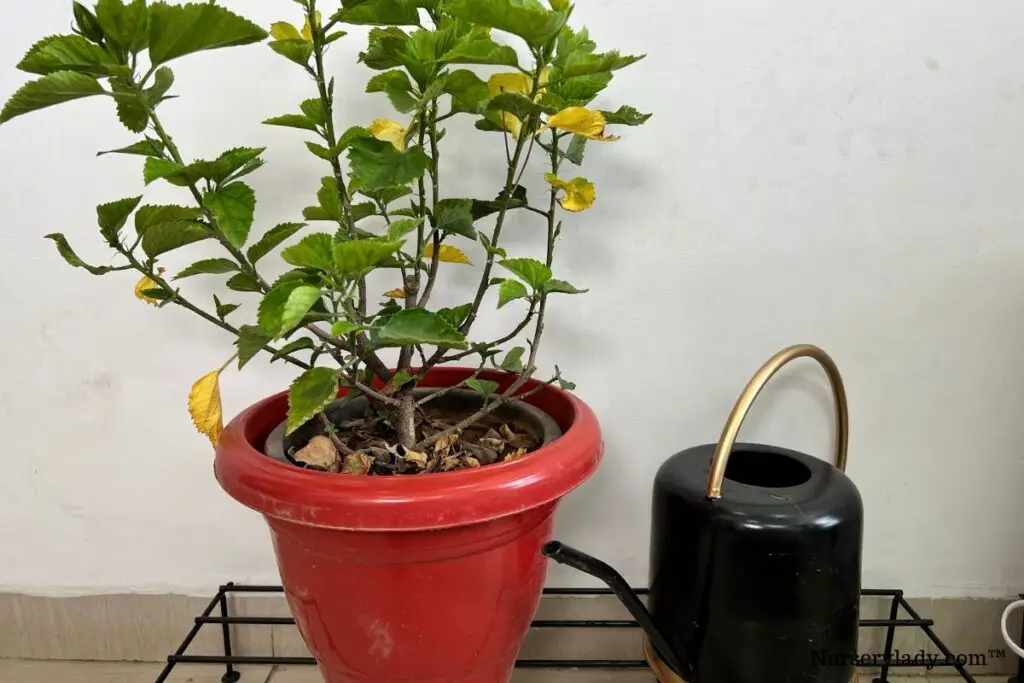
Hibiscus watering needs and frequency
To fulfill the watering needs of Hibiscus plants, you should understand how often to water the plant.
However, it depends on various circumstances.
After recent planting, water the plant daily for the first week to help them get settled.
Reduce watering to every other day in the second week.
Though the frequency will differ depending on seasons and other factors, usually water the plant 4-5 times per week.
In general, Hibiscus needs water more or less daily once established during the growing months, i.e., spring and summer.
Moreover, the big flowers need more moisture and, thus, more water when blooming.
Below, I have shared some circumstances where the watering needs of Hibiscus will differ.
Summer watering
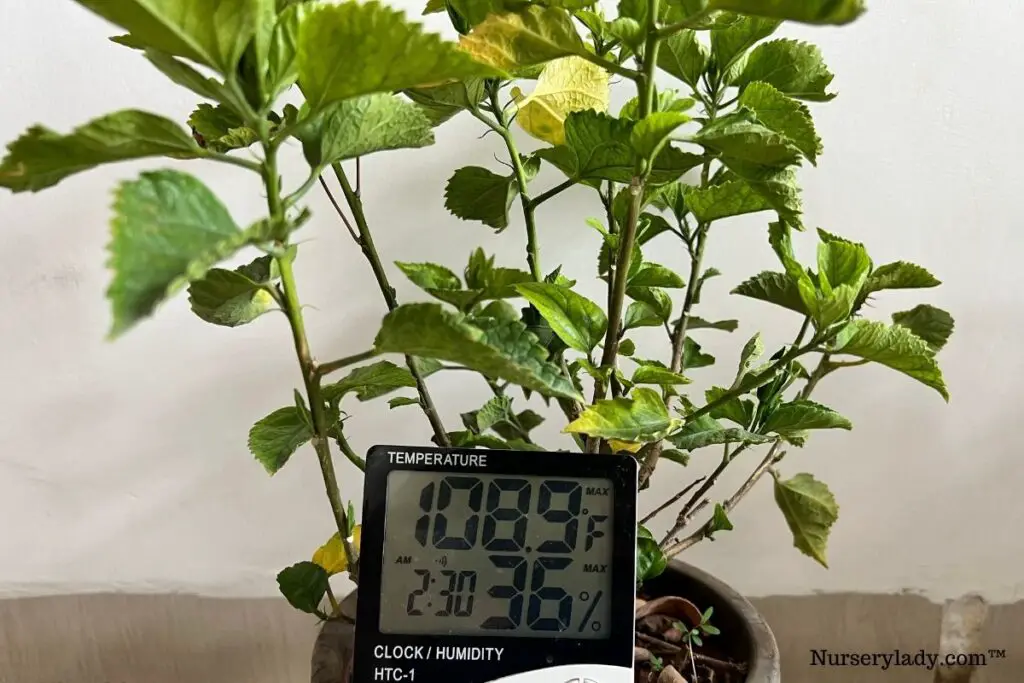
Hibiscus requires watering daily during the summer months, especially when the weather gets too hot and dry.
Hibiscus enjoys moist soil, and the flowers need to have ample moisture for big blooms.
Since they dry out in summers due to the excessive heat and dry weather, you must give them enough water to keep hydrated.
Sometimes, you might have to water them twice a day in the sweltering climate.
But perform the main watering in the morning.
If you ever forget or don’t have time to water the Hibiscus twice a day, place a shading cloth to prevent the scorching sun from reaching the soil bed and drying them faster.
If your Hibiscus is in a container, shift the plant to a bigger pot.
As a big planter needs lots of soil, it will take water to dry out after watering.
Winter watering
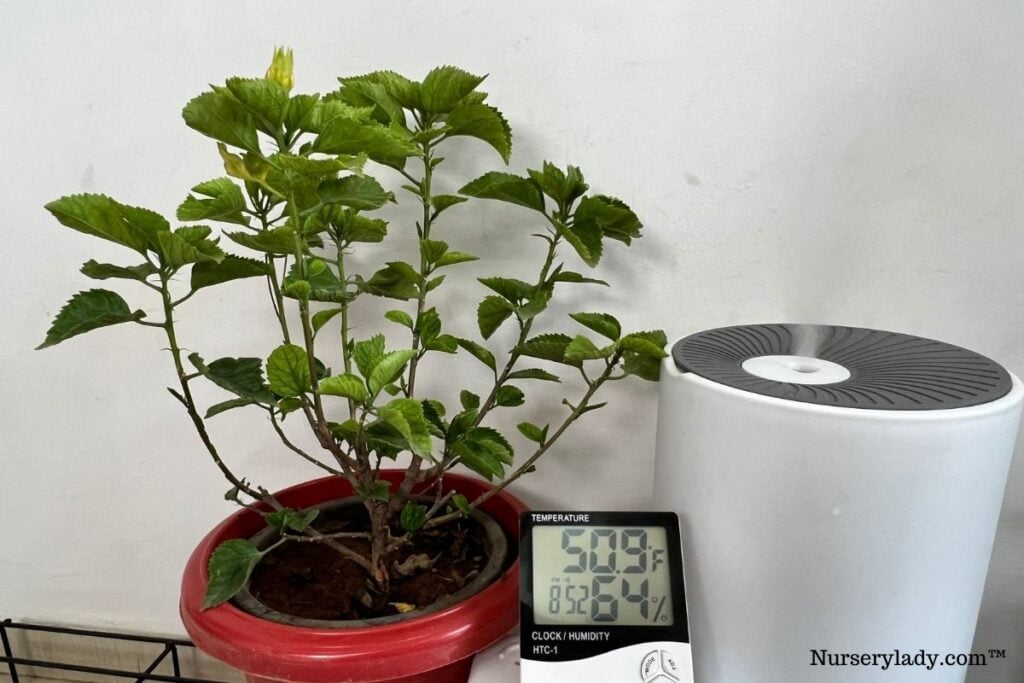
Winter is when the temperatures are low and sun hours are shorter.
As a result, it is not an ideal climate for tropical plants like Hibiscus.
Since they are native to tropical areas, they are not meant for the colder months of the year.
They will slow down their growth, and as a result, they will need very less watering than in spring and summer.
When the temperature cools down from the autumn, you should start to check the soil and decrease watering.
There is no fixed frequency routine for winter watering.
But, you must only provide the plant with water when the top 1-2 inches of the soil feels dry to touch.
Indoor and outdoor watering
When Hibiscus is outdoors, they receive direct sunlight, excessive heat, and winds responsible for the fast drying of the soil.
So, you have to water the outdoor plants more frequently.
Sometimes, they will need watering twice a day.
If your plant is indoors, it won’t get direct sunlight or heat like outdoor plants.
However, you still have to water them daily.
But, you don’t have to water them 2-3 times in one day like the outdoor plants.
Other essential considerations
If you live in a region with low rainfall, you have to give the water according to the soil condition.
But if your area receives frequent rainfall, you can skip watering and reduce the frequency.
During extreme windy weather, check the soil and water them as needed.
Too much wind can erode the soil and dry it out quickly.
So, you might have to water the plant more than twice.
On the contrary, reduce watering if the weather is cloudy or rainy.
Does Hibiscus need a lot of water?
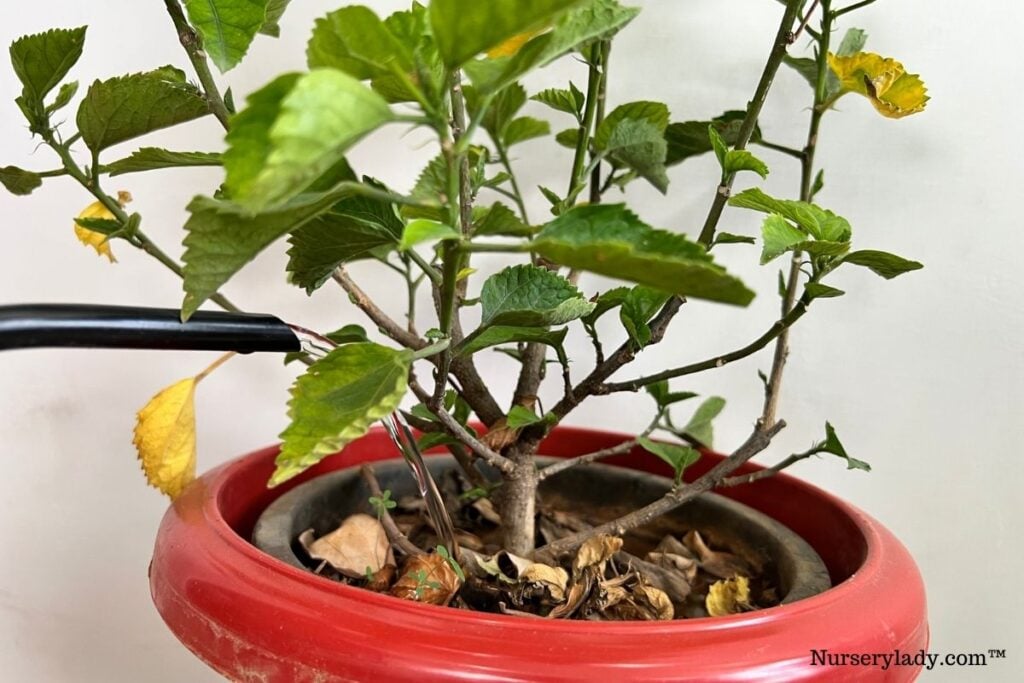
There is no specific amount of water to provide Hibiscus with.
When watered, they absorb a small amount of water, and the rest is expelled through guttation and transpiration.
The less the humidity, the less water they will expel.
In that case, they will drink less water.
However, many other factors besides seasons determine the frequency of watering.
If you follow a strict routine according to a clock or calendar, your plant will easily face overwatering or underwatering and make your plant prone to diseases or death.
If you are a beginner, check the top 1-2 inches of the soil before watering. If it is dry, water the plant. If not, wait for some days.
Factors determining how much and how often to water Hibiscus
Here are some factors that determine the watering needs of Hibiscus besides seasons, indoor and outdoor placements:
- Light
- Soil
- Container
- Temperature
- Humidity
Now let’s learn in detail how these factors affect watering needs.
Looking for gardening supplies? We have tested 100's of products before recommending them to you guys. Check out our best pick below:
| Image | Gardening Supplies | Best Price? |
|---|---|---|
 Top
Top Top
Top | Raised Garden Bed Kit | Check On Amazon |
 | XLUX Soil Moisture Meter, Plant Water Monitor, Soil Hygrometer Sensor for Gardening, Farming, Indoor and Outdoor Plants, No Batteries Required | No Results |
 Top
Top Top
Top | 82 Pcs Garden Tools Set and Extra Succulent Tools Set | Check On Amazon |
 | Joeys Garden Expandable Garden Hose with 8 Function Hose Nozzle, Lightweight Anti-Kink Flexible Garden Hoses, Extra Strength Fabric with Double Latex Core, (50 FT, Black) | No Results |
 Top
Top Top
Top | Dual Chamber Compost Tumbler | Check On Amazon |
 Top
Top Top
Top | Sunnyglade Plant Stakes | Check On Amazon |
 Top
Top Top
Top | Organic Cold Pressed Neem Seed Oil | Check On Amazon |
 Top
Top Top
Top | Mighty Mint Gallon :-Insect and Pest Control Peppermint Oil | Check On Amazon |
 Top
Top Top
Top | Scotts DiseaseEx Lawn Fungicide | Check On Amazon |
 Top
Top Top
Top | Jacks Classic 20-20-20 All Purpose Fertilizer | Check On Amazon |
 Top
Top Top
Top | 30,000 Seeds Pollinator Attracting Wildflower Mixture | Check On Amazon |
 Top
Top Top
Top | Survival Vegetable Seeds Garden Kit-Over 16,000 Seeds | Check On Amazon |
Light
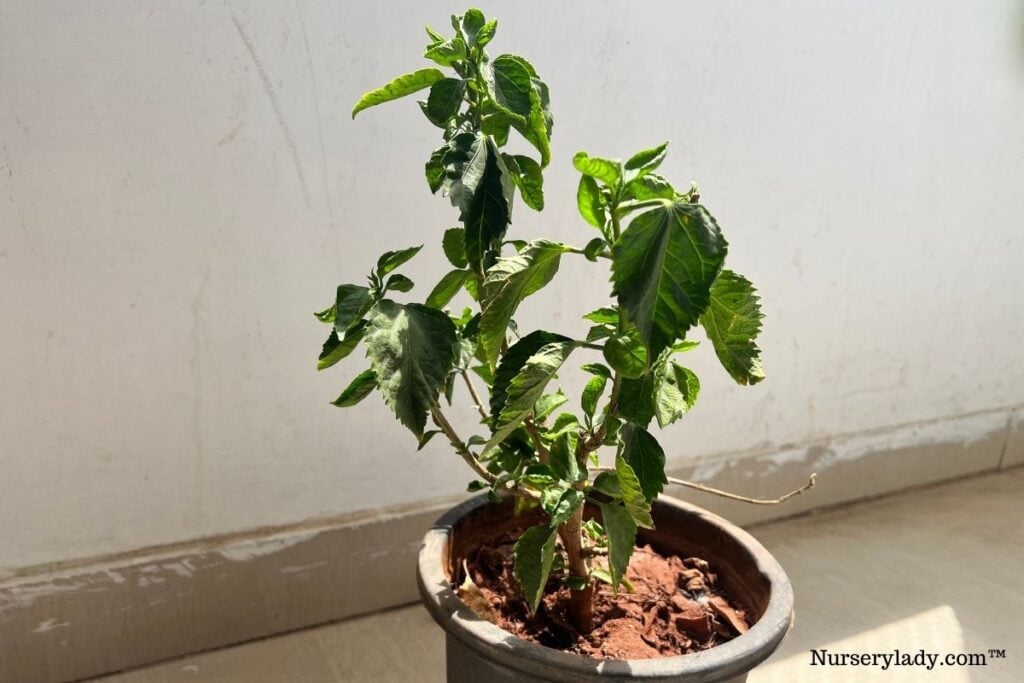
Hibiscus requires daily 6-8 hours of full sun to thrive.
If planted in a spot that receives 6-8 hours of direct sunlight daily, the plant will need daily watering or two times per day.
They will photosynthesize well under the full sun and thus uptake water more vigorously.
Additionally, the soil will dry out faster due to exposure to the sun’s heat.
That is why they will need watering more often when they receive enough sunlight.
Without enough water, the plant will suffer underwatering easily.
So, don’t forget to water timely.
But, if your plant is under partial shade or filtered sun, it will consume water gradually, and the soil will dry slowly.
In such a case, water the plant only once daily.
Soil

Though they enjoy moist soil, they will grow best when planted in well-drained soil amended with organic matters.
The soil should be well-drained and also moisture-retentive to some extent.
If you use well-drained soil for Hibiscus, you can follow the usual watering routine.
It won’t take much time to dry out.
This means you can water them daily.
But if the soil is not good enough in drainage and retains moisture longer than usual, then increase the gap between the watering cycles.
Give 1-2 days gap between each watering for the soil to dry out.
If your garden’s soil is clayey, add some sand to improve the drainage.
Or, create raised bed for Hibiscus to prevent the excess build-up of water.
Container
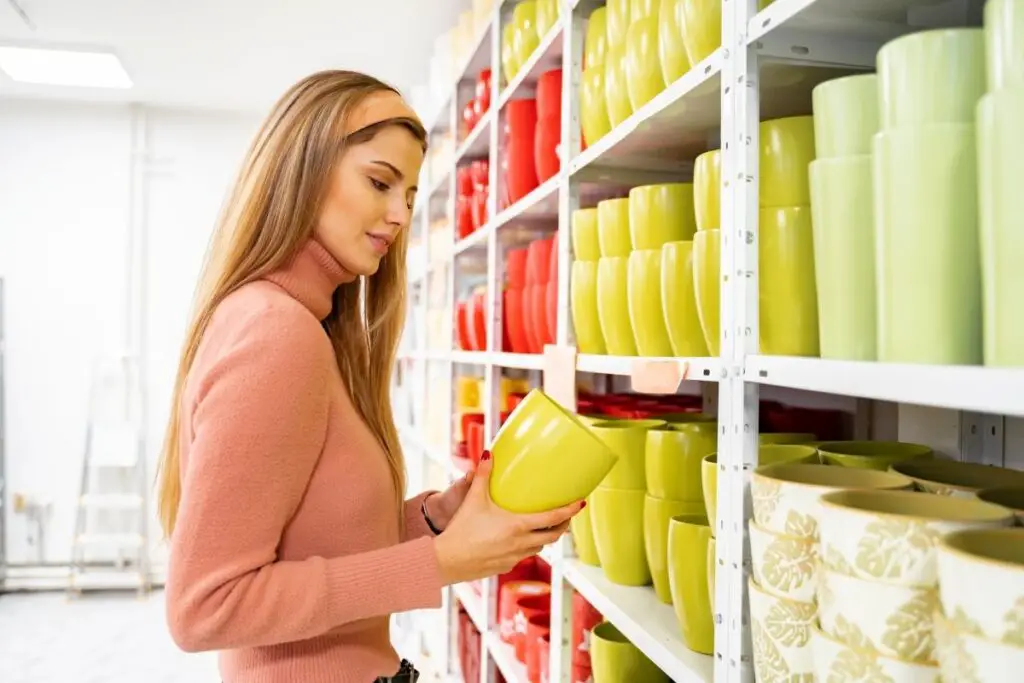
If you have planted Hibiscus on the grounds, this point is not for you.
The size and type of the container will also determine the watering needs of the Hibiscus plants.
A large pot requires a lot of soil. When you provide sufficient water to wet the soil completely, it will take time to dry out.
In such a condition, water the plant less often.
However, you still have to water them daily during summer.
But you might not have to give them water for the second or third time.
On the contrary, if your plant is in a small pot, the water will drain faster due to less soil.
So, you have to give more water here.
The material of the container also plays a vital role.
Terracotta pots are made of porous materials and thus, can wick away moisture quickly.
Water the plant more if your Hibiscus is in a terracotta pot.
On the other hand, plastic and ceramic pots can hold moisture for a long time.
If you have used plastic or glazed pots for Hibiscus, give the plant less water.
You can also use self-watering pots for Hibiscus if you don’t have time to maintain the water needs.
Also, make sure the drainage system of the pot.
Otherwise, the plant will experience overwatering.
Temperature

When the outside temperature ranges above 70-80°F, the evaporation rate increases greatly, and so does transpiration.
In such conditions, give Hibiscus more water. It is common in the summers when the weather gets too scorching.
I have mentioned previously that you might have to water the Hibiscus twice a day daily, especially when the temperature ranges between 80-90°F.
But, if the temperature is low, the plant will demand less watering due to low evaporation and shorter daylight hours.
So, at such a time, give them water less often. Don’t forget to check the soil’s moisture level before watering.
Humidity
The more the humidity, the less water will be plant need.
High humidity increases the moisture level around the plant to a great extent.
So they don’t require frequent watering.
Since the Hibiscus is a tropical plant, it will enjoy high humidity.
If exposed to extremely dry weather, Hibiscus will require more water.
But, there is a twist. Winter seasons have low humidity.
That doesn’t mean you should provide them with more water.
You should check the soil’s moisture before watering.
If you think that the outdoor Hibiscus is not getting enough humidity, you can increase it by keeping some water trays around the plant.
If your plant is in a pot, perform group planting.
But also ensure enough airflow as too much high humidity results in mold formation.
You can put the potted plant over a saucer having water and pebbles.
When the temperature increases, the water in the saucer will evaporate and increase the humidity level.
Use humidifiers for indoor Hibiscus.
If you are unaware of the humidity around your plants, use a hygrometer to know it.
The reading on the screen device will tell you whether the plant is getting enough humidity or not.
How to tell when Hibiscus needs water?
If you are a beginner at gardening and have started it with Hibiscus, you might wonder how to know when it requires water.
Below are some steps you can follow to understand when the plant needs water.
Moisture meter
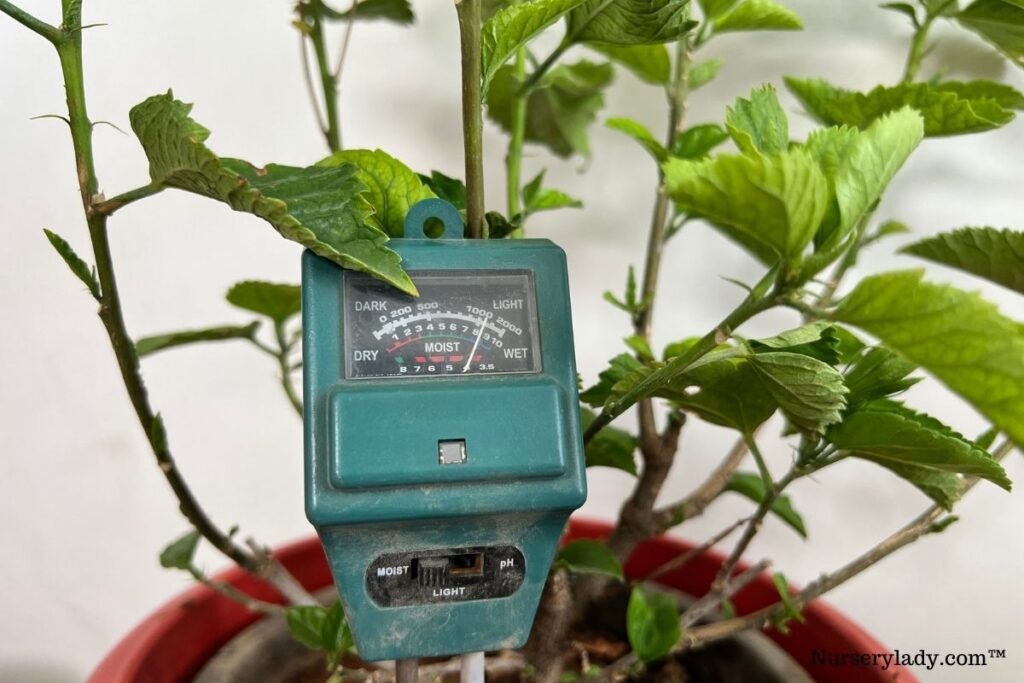
A moisture meter is a device that gives a perfect measurement of the soil’s moisture level.
It is helpful mainly for beginners who fail to do the finger test or are unaware of the right watering frequency.
The meter consists of a screen where the device will show the result.
If the moisture meter shows results between 1 and 3 on the screen, you need to water the plant.
But, if it’s more than 3, wait for some more days to water.
Use your finger
This is easy.
Once you learn it right, you won’t require any devices.
Insert your finger 2-3 inches deep into the soil.
If the soil feels cold or mud sticks to your finger when you take it out, the soil has enough moisture. Wait for some more days to water the plant.
But, if the soil feels dry and no mud sticks to your finger, it is time to water the plant.
Pot lifting
Now, this applies to the potted Hibiscus.
By lifting the pot, you will feel its weight to understand whether it needs water or not.
If the pot feels light after lifting, it is time to water the plant.
But, if it feels slightly heavy, you don’t have to water them for now.
Pot color
If you use a terracotta pot for Hibiscus, the pot will seem dark when the soil holds enough moisture.
On the contrary, if the pot seems light-colored, you can give them water.
Touching the pot
This will again work for terra cotta or clay-based pots.
When there is enough moisture, the pot will feel wet.
Otherwise, it will feel dry when touched.
What kind of water is good for Hibiscus?
While watering Hibiscus, the water’s type and quality are also important.
With the poor water quality, the plant will not show any progressive results.
Water type
Rainwater is the first option. The second is distilled water.
If you use distilled water, add some hydrogen peroxide to it during every few watering.
This gives the distilled water a touch of natural rainwater.
Hibiscus is tolerant to most types of water.
You can use common tap water.
Though Hibiscus can absorb the mineral content of tap water, many complain about its quality.
So, tap water should be your last option.
If you don’t have any other option than tap water, let it sit overnight for the minerals to evaporate.
Never use tap water directly.
It will change the soil’s pH level and affect the plant’s growth.
The pH level
Tap water contains a lot of minerals and increases or lessens the soil’s pH level and harms the plant.
The plant will only thrive if they receive water having pH levels between 5.0 and 7.0.
However, slightly hard water is tolerable but not too much.
If the pH level is too high or too low, the water has many harsh minerals.
In such a case, contact the municipality to know the water quality.
They will also help you measure the water pH level and how you can combat it if it’s high or low.
You can also use some measurement devices to know the pH values and mineral content present in the soil.
The temperature of the water
Coldwater reduces the temperature of the body.
It is good during the winters as we feel less cold.
But it is not good for summer.
Coldwater functions in the same way as plants.
Giving them cold water in the summers to cool them down only gives a shock to the whole plant system, especially during the summers.
You must provide them with tepid or room temperature water always.
You can also give tolerable warm water in the winters.
But it should not be hot.
It will help to mimic the tropical conditions Hibiscus is habituated to.
How to water Hibiscus plants?
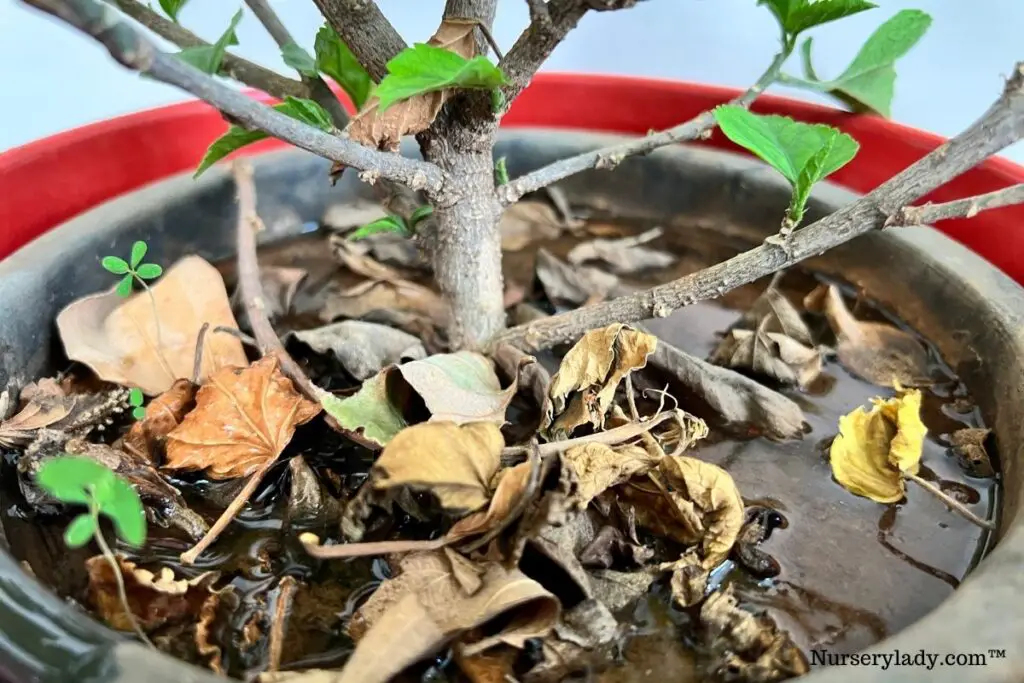
When you water the Hibiscus plants, you have to soak the soil fully.
The lengths of the roots are generally 6 inches.
When you give them water, the water must reach the roots.
It is possible by installing a dripping system or using soaker hoses.
You can use more than one soaker hose, depending on the size of the plant.
Put the first soaker hose 6 inches away from the plant base and encircle it.
Now, put the other 6 inches apart until it reaches 1 foot beyond the drip line.
Make a hole 6 inches deep at the drip line.
Measure the time it takes to damp the bottom of the hole and then determine the time for running the hoses.
There are other methods too for watering Hibiscus.
They are applicable for potted Hibiscus plants.
If you are growing outdoor Hibiscus in pots, use these methods:
Top watering
In this method, you will water the plant from the top, close to the soil.
Continue watering the plant until you see the excess water draining out of the drainage holes.
It also helps flush off the excess minerals and salts from the soil.
Bottom watering (For potted hibiscus)
Here, you will place the pot in a container filled with water.
The soil will get moist through the drainage holes.
Let it stay for 10-15 minutes until the soil has moistened completely.
What are the results of too much water?
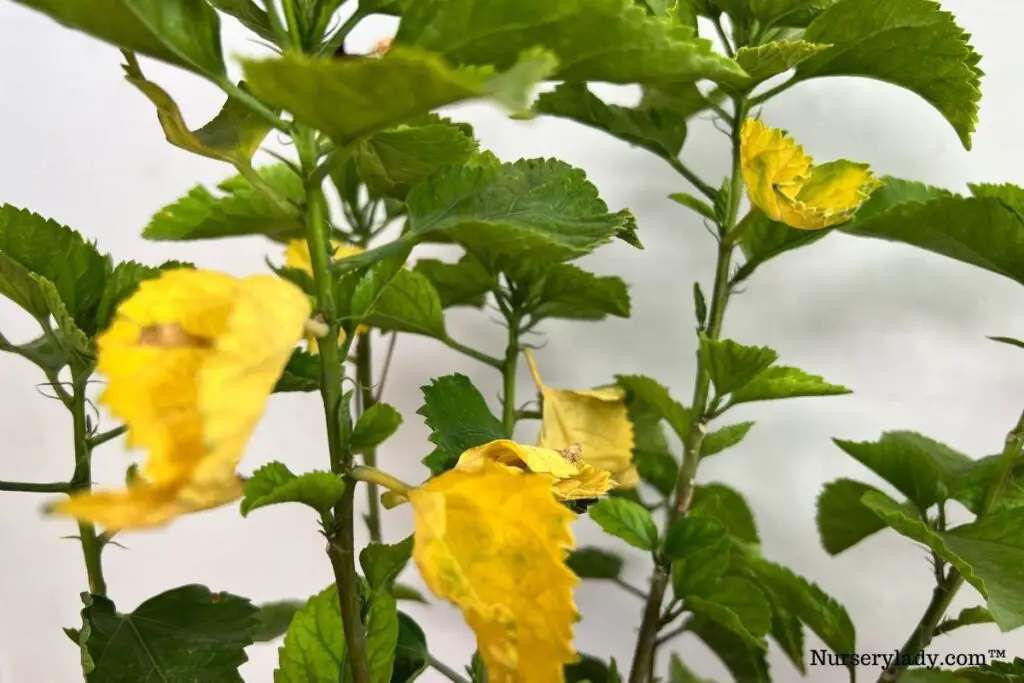
Though Hibiscus enjoys moist soil, they hate waterlogged soil.
If the plant is standing over wet soil for prolonged periods, it will cause overwatering.
In worse conditions, the plant will undergo root rot.
The signs of overwatering are:
- Leaves turning yellow
- Droopy leaves
- Excessive wet soil
Check the roots.
There might be soft and dark brown roots, indicating rot.
The soil and the roots will release a foul odor.
How to fix the problem?
- If you suspect that you gave too much water, wait for 90 minutes after watering.
- If the soil is wet, you have to change the watering routine.
- Stop watering for some time and start when the top 1-2 inches are dry.
- Empty the saucer beneath the potted plant if filled with too much water.
- Let the plant have warm weather and some partial sunlight for fast drying the soil.
- Trim the affected parts from the plant.
- If roots are dark brown and soft and releasing a foul odor, repot the plant or change the location if it’s in the ground.
- Reduce watering during winters.
Is my Hibiscus thirsty?
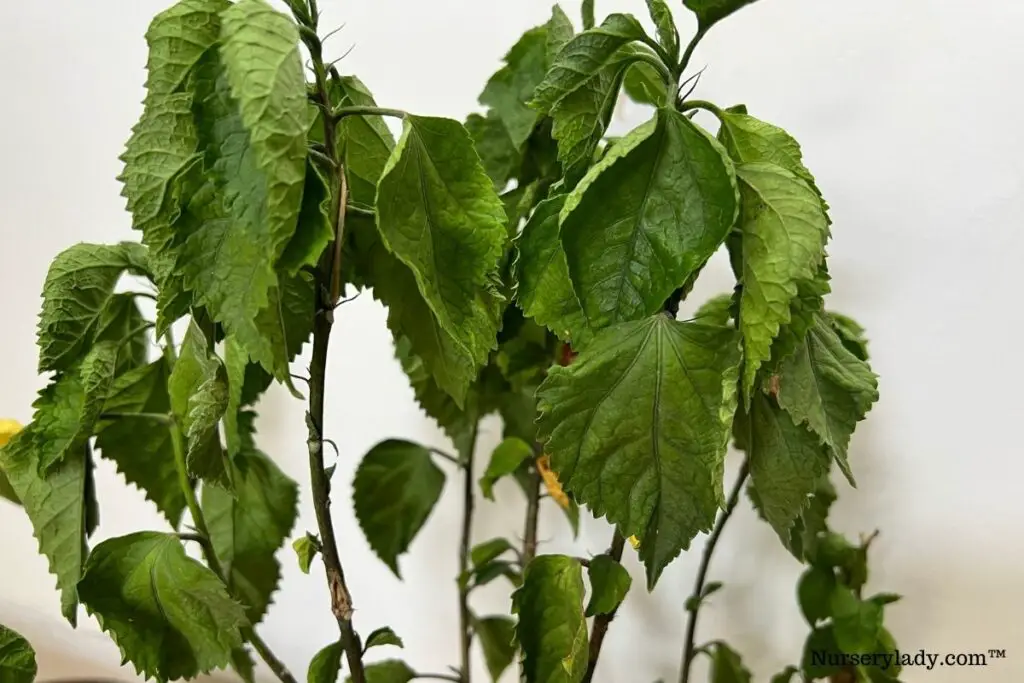
It is very easy to underwater the Hibiscus plants because most people run out of time to maintain the right watering.
Without enough water, the plant will struggle to grow and flower.
The signs of underwatering are:
- Flowers wilting
- The soil feels too dry.
- Yellow, brittle leaves
- Leaves curling upwards and shrinking.
- Dry and crispy leaves
How to save the plant from underwatering?
- Give your plant a good drink by soaking.
- During the summers, frequently check the soil’s moisture and don’t forget to water them.
- If you don’t have time to water them twice or thrice a day, at least maintain one time and water them daily.
- Increase watering frequency if the weather is scorching.
Final thoughts
With proper care and maintenance, your Hibiscus can remain healthy in the long term. Water them daily during the spring and summer. Sometimes, you have to water twice in the summer, and reduce watering in winter.
Don’t forget to check the soil’s moisture level before watering. Water the plant if the top 1-2 inches of the soil is dry.
Reference: Wikipedia, ASPCA, Louisiana State University Agricultural Center, American Society for Horticultural Science, Tropical Hibiscus by Texas A&M University, Sciencedirect.
